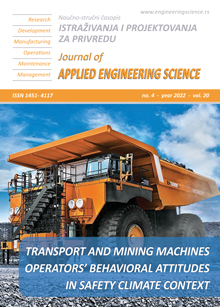NEW ALGORITHM FOR CALCULATING THE REQUIRED NUMBER OF UNMANNED AERIAL VEHICLES AND THE DURATION OF THEIR STAY IN DANGEROUS AREA
Abstract
This paper proposes a new approach to calculate the time spent by unmanned aerial vehicle (UAV) in dangerous area with the consideration of the maximum allowed probability of losing UAV and the increasing rate of this probability in a given area. Unlike the known approaches, which are based on flying around the dangerous areas, it is proposed to cross the boundaries of the dangerous area for a defined time, which is calculated to allow the obtaining of the required data set about the interested area. Based on the UAV loss probabilities estimates, an approach to planning the number of UAVs in a group flight is substantiated, taking into account losing them. The formula for calculating the required number of UAVs, obtained by this approach, consists of three terms, which consider the requirements for pre-flight task accomplishment, high-quality in-flight service of new requests, as well as the necessary reserve in case of the decrease of UAV performance. To evaluate the quality of the proposed algorithm, various case with different initial conditions in determining the time of stay in dangerous zone are considered. The specified time minimizes the given indicator. In addition, the paper presents practical example where the algorithm is used to observe a territory by a group of UAVs. It is shown that the algorithm can determine the required number of UAVs to study an area with a given dimension, and it also can calculate the time of stay of each UAV in the dangerous area in order to reduce the loss probability of UAVs.
References
Arnold, R.D., Yamaguchi, H., Tanaka, T. (2018). Search and rescue with autonomous flying robots through behavior-based cooperative intelligence. Int J Humanitarian Action, vol. 3, no. 18, DOI: https://doi.org/10.1186/s41018-018-0045-4.
Kuznetsova, O.N., Poberezhnyuk, N.S. (2018). The use of UAVs to ensure the safety of dangerous industrial facilities. Fire safety: problems and perspectives, vol. 1, no. 9, p. 494-496, from https://elibrary.ru/download/elibrary_36576243_42104470.pdf, accessed on 2022-01-28.
Merino L., Martínez de Dios J., Ollero A. (2015). Cooperative Unmanned Aerial Systems for Fire Detection, Monitoring, and Extinguishing. Valavanis K., Vachtsevanos G. (Eds.), Handbook of Unmanned Aerial Vehicles, Springer Dordrecht, p. 2693-2722, DOI: https://doi.org/10.1007/978-90-481-9707-1_74.>
Marusin, V.S., Ponomarev, O.P., Stolyarov, O.G., Temerov, O.P. (2019). Algorithms for optimizing the flight route of an aircraft. Bulletin of the Concern VKO Almaz-Antey. no. 1(28), p. 98-104, from https://cyberleninka.ru/article/n/algoritmy-optimizatsii-marshruta-poleta-letatelnogo-apparata, accessed on 2022-01-28.
Jun M., D’Andrea R. (2003). Path planning for unmanned aerial vehicles in uncertain and adversarial environments. Kluwer, S. Butenko, R. Murphey, P. Pardalos (Eds.), Cooperative control: models, applications and algorithms, Springer, Boston, MA, p. 95-110, from http://www.seas.ucla.edu/coopcontrol/papers/02cn04.pdf, accessed on 2022-01-28.
Bugakov, I.A., Sorokin, A.D., Khomyakov, A.V. (2019). Indicators of the effectiveness of the use of a group of unmanned aerial vehicles in solving the problem of aerial reconnaissance in the face of enemy opposition. Bulletin of the Institute of Engineering Physics, no. 1(51), p. 65-68, from https://elibrary.ru/download/elibrary_36948584_14690835.pdf, date of access 2022-01-28.
Afonin, I.E., Makarenko, S.I., Petrov, S.V., Privalov, A.A. (2020). Analysis of the experience of combat use of unmanned aerial vehicles groups to destroy anti-aircraft missile systems of the air defense system in military conflicts in Syria, Libya and Nagorno-Karabakh. Control Systems, Communications and Security, no. 4, p. 163-191. DOI: 10.24411/2410-9916-2020-10406, from http://sccs.intelgr.com/archive/2020-04/06-Afonin.pdf, date of access 2022-01-28.
Wang, X., OuYang, C., Shao, X., Xu, H. (2021). A method for UAV monitoring road conditions in dangerous environment. Journal of Physics: Conference Series. 1792(1), p. 012050, DOI: 10.1088/1742-6596/1792/1/012050.
Wen, N, Zhao, L, Su, X, Ma, P. (2015). UAV online path planning algorithm in a low altitude dangerous environment. IEEE/CAA Journal of Automatica Sinica, 2, p. 173-185, DOI: 10.1109/JAS.2015.7081657.
Goncharenko, V.I., Zheltov, S.Yu., Knyaz, V.A., Lebedev, G.N., Mikhaylin, D.A., Tsareva, O.Yu. (2021). Intelligent System for Planning Group Actions of Unmanned Aircraft in Observing Mobile Objects on the Ground in the Specified Area. Journal of Computer and Systems Sciences International, vol. 60, no. 3, p. 379–395, DOI: 10.1134/S1064230721030047.
Zabarankin, M., Uryasev, S., Pardalos, P. (2006). Optimal Risk Path Algorithms. Department of Industrial and Systems Engineering, University of Florida, DOI: 10.1007/0-306-47536-7_13, from https://www.researchgate.net/publication/226885871_Optimal_Risk_Path_Algorithms, accessed on 2022-01-28.
Bryson, A., Ho, Y-c. (1972). Applied theory of optimal control, Mir, Moscow, from https://booksee.org/book/725806, accessed on 2022-01-28.
Verba, V.S., Gandurin, V.A., Merkulov, V.I. (2014). Vitality of aviation complexes of radar patrol and guidance, vol. 2, p. 112-118, from https://library.bmstu.ru/Catalog/Details/369819, accessed on 2022-01-28.
Moiseev, V.S. (2017). Group application of unmanned aerial vehicles, RIC School, Kazan, from http://xn----8sbccoat3acurs.xn--p1ai/files/monography_3.pdf, accessed on 2022-01-28.
Md, A.Q., Agrawal, D., Mehta, M., Sivaraman, A.K., Tee, K.F. (2021). Time Optimization of Unmanned Aerial Vehicles Using an Augmented Path. Future Internet, vol. 13, no. 308, p. 1-14, DOI: https://doi.org/10.3390/fi13120308.
Biswas, S, Anavatti, S.G., Garratt, M.A. (2021). Path planning and task assignment for multiple UAVs in dynamic environments. Unmanned Aerial Systems, Academic Press, p. 81-102, DOI: https://doi.org/10.1016/B978-0-12-820276-0.00011-X.
Majeed, A., Hwang, S. O. (2021). Recent Developments in Path Planning for Unmanned Aerial Vehicles. García, E. A. M., (Eds.), Motion Planning [Internet]. London: IntechOpen. Available, from https://www.intechopen.com/chapters/78404 DOI: 10.5772/intechopen.99576, accessed on 2022-01-28.
Garibeh, M., Alshorman, A., Jaradat, M., Younes, A., Khaleel, M. (2022). Motion planning of unmanned aerial vehicles in dynamic 3D space: A potential force approach. Robotica, p. 1-27, DOI: 10.1017/S026357472200042X.
Yao, M., Zhao, M. (2014). Unmanned aerial vehicle dynamic path planning in an uncertain environment. Robotica, vol. 33, no. 3, p. 611-621. DOI: 10.1017/S0263574714000514.
Henderson, I., Watts, R., Seed, I., other (2019). Research and analysis. Unmanned Aerial Vehicles (UAVs) in Nuclear Decommissioning – Current Use and Future Opportunities. Nuclear Decommissioning Authority, from https://assets.publishing.service.gov.uk/government/uploads/system/uploads/attachment_data/file/990256/UAVs_in_Decommissioning_-_Report.pdf, accessed on 2022-01-28.
Rudnick-Cohen, E., Azarm, S., Herrmann, J. (2015). Multi-Objective Design and Path Planning Optimization of Unmanned Aerial Vehicles (UAVs). Vehicle Design Applications, DOI:10.2514/6.2015-2322, from https://doi.org/10.2514/6.2015-2322.

